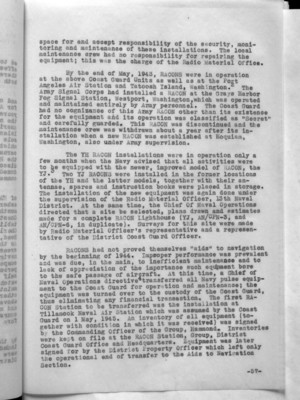Pages That Mention Port Angeles Air Station
Coast Guard District narrative histories 1945
11
labor consumed far too much valuable time, and so it became expedient that there be a swifter method. By 1942, Headquarters developed a radio control system for aids to navigation intended primarily for blacking out unattended lighted aids by means of radio signal. The system was designated by the coined word "RACAN" which was later changed to ANRAC to avoid confusion with RADAR beacons or RACONS.
After a thorough study of the use of ANRAC, the District Coast Guard Officer, 13th Naval District, requested Headquarters' authority to install the equipment with the Cape Disappointment Light Station as the control unit for the radio extinguishing of ten buoys in the lower Columbia River. Because of the delay in the delivery of ANRAC equipment, it was not until March, 1944 that the first two ANRAC equipped buoys were placed on station. All maintenance and repair work for this installation of special buoy equipment was handled at the Tongue Point Repair Base, Tongue Point, Oregon. Later at the request of the Commandant, 13th Naval District, the District Coast Guard Officer requested that ANRAC controlled buoys be placed in the Grays Harbor and Willapa Bay areas. Headquarters authorized these installations, but later experiments with ANRAC did not prove satisfactory and permission was requested of Headquarters to discontinue this type of equipment. This request to remove ANRAC equipment from the Columbia River, Grays Harbor, and Willapa Bay was finally approved.
Early in 1943, the Navy had decided to install RACONS on Coast Guard Light Stations at Cape Arago, Cape Blanco, Heceta Head, and Yaquina Head in Oregon. Sixteen Coast Guardsmen were schooled in the operation and maintenance of RACON equipment at a one week training course at the Naval Air Station, Seattle, a short time before the installations were completed. By the end of May, 1943, RACONS were in operation at the above Coast Guard units as well as at the Port Angeles Air Station and the Cape Flattery Light Station.
At the beginning of 1944, the Chief of Naval Operations directed the transfer of all Navy "pulse" equipment to the Coast Guard for operation and maintenance. The first RACON station to be transferred was the installation at Tillamook Naval Air Station which was assumed by the Coast Guard on 1 May, 1945. The stations at Shelton, Quillayute, Whidby Island, and Seattle in the state of Washington, and Astoria, and Oceanside in Oregon were transferred to the Coast Guard. Other RACON units were established subsequently in the 13th Naval District. At the conclusion of the war, various Auxiliary Stations were discontinued and the RACON stations at each were placed in caretaker status.
-28-
77
space for and accept responsibility of the security, monitoring and maintenance of these installations. The local maintenance crew had no responsibility for repairing the equipment; this was the charge of the Radio Material Office.
By the end of May, 1943, RACONS were in operation at the above Coast Guard Units as well as at the Port Angeles Air Station and Tatoosh Island, Washington. The Army Signal Corps had installed a RACON at the Grays Harbor Fog Signal Station, Westport, Washington, which was operated and maintained entirely by Army personnel. The Coast Guard had no cognizance of this Army RACON other than its existence for the equipment and its operation was classified as "Secret" and carefully guarded. This RACON was discontinued and the maintenance crew was withdrawn about a year after its installation when a new RACON was established at Hoquiam, Washington, also under Army supervision.
The YH RACON installations were in operation only a few months when the Navy advised that all activities were to be equipped with the newer, improved model of RACON, the YJ.³ Two YJ RACONS were installed in the former locations of the YH and the latter models, together with their antennae, spares and instruction books were placed in storage. The installation of the new equipment was again done under the supervision of the Radio Material Officer, 13th Naval District. At the same time, the Chief Of Naval Operations directed that a site be selected, plans drawn and estimates made for a complete RACON Lighthouse (YJ, AN/CPN-3, and AN/CPN-6, in duplicate). Surveys for this site were made by Radio Material Officer's representative and a representative of the District Coast Guard Officer.
RACONS had not proved themselves "aids" to navigation by the beginning of 1944. Improper performance was prevalent and was due, in the main, to inefficient maintenance and to lack of appreciation of the importance such equipment bore to the safe passage of aircraft. At this time, a Chief of Naval Operations directive^4 transferred all Navy pulse equipment to the Coast Guard for operation and maintenance; the equipment was turned over to the custody of the Coast Guard, thus eliminating any financial transaction. The first RACON Station to be transferred was the installation at Tillamook Naval Air Station which was assumed by the Coast Guard on 1 May, 1945. An inventory of all equipment (together with condition in which it was received) was signed by the Commanding Officer of the Group, Hammond. Inventories were kept on file at the RACON Station, Group, District Coast Guard Office and Headquarters. Equipment was later signed for by the District Property Officer which left only the operational end of transfer to the Aids to Navigation Section.
-57-

